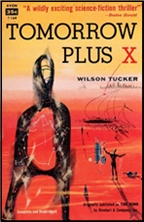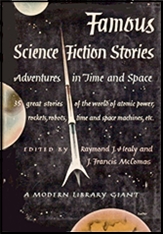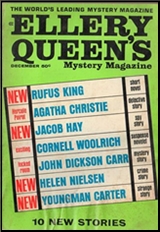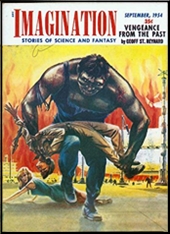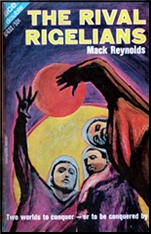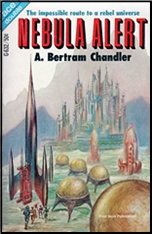WORLDS OF TOMORROW. November 1966. Overall rating: 3 stars.
LIN CARTER “Crown of Stars.†Novelette. Tongue-in-cheek adventure with Hautley Quicksilver, Confidential agent, as he attempts to steal a jeweled crown. The over-eloquent descriptive style slows things down too much. (3)
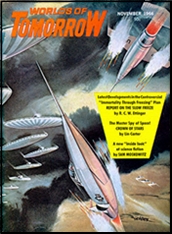
Update: While the story doesn’t appear to have been either collected or reprinted, it’s fairly clear that it was the basis for Carter’s novel The Thief of Thoth (Belmont Double, paperback original, 1968). Here’s a synopsis of that book which I found online:
“Hautley Quicksilver is a licensed thief and considered the best in the business.. A man posing as an archeologist, a planetary prince and an intelligence agent acting on orders from the Emperor’s cabinet approach Quicksilver separately. They all want him to steal the Crown Of Stars. It’s an artifact from the long gone Cavern Kings Of Toth. They were a lizard like race and the cave containing the Crown is guarded by a fanatical cult.â€
A followup novel in the same series, The Purloined Planet, was published the following year, also by Belmont. I used to like Carter’s novels, almost all of them pastiches of other author’s series, but that was when I was a whole lot younger. I’d like to give the expanded novel a try, though, whenever I find my copy.
C. C. MacAPP “Frost Planet.†Novelette. Murder and sabotage in an Earth enclave disrupts relations with the natives. The motives behind the plot are poorly defined, and the physical background has little bearing on the story. (2)
Update: The story has never been collected or reprinted. C. C. MacApp was a pen name of Carroll Mather Capps, and while he wrote seven novels between 1968 and 1972, I don’t recall reading any of them.
RICHARD C. MEREDITH “To the War Is Gone.†Novelette. Illustrating a poem of Thomas Moore, a minstrel goes to war and dies in the fight against slavery. His sole opponent in his final conflict is a beautiful girl, who holds his life in her hands, just as he is the only one who can save her. (5)
Update: This was Meredith’s second published story. I wish I’d said more about the time and place where it was set. It was never reprinted or collected. Meredith wrote seven novels between 1969 and 1979, including three in his “Timeliner†series. I remember enjoying them, but the details are long gone.
DANNIE PLACHTA “Until Armageddon.†A computer announces the beginning of the Hour of Judgment. (3)
Update: At only two pages in length, this was obviously only a filler for this issue. It is possible that I once met the author. One online source describes him as an active participant in the Detroit fandom in the 1960s, which I was tangentially involved with when I lived in Ann Arbor.
STEPHEN TALL “Seventy Light-Years from Sol.†Short novel. An exploration team discovers a new evolutionary system, consisting of cubes and millwheels on a planet covered with lettuce. [At 40 pages in length] about ten pages too long. (3)
Update: Collected in The Stardust Voyages (Berkley, paperback original, 1975) as “A Star Called Cyrene.†There was a followup novel in the same series, The Ramsgate Paradox (Berkley, paperback original, 1976). I own both books, but alas, I’ve managed to read neither one.
– August 1967
Overall thoughts: I rated this three stars out of five, which is a notch above average. That’s about right. Worlds of Tomorrow was my favorite science fiction magazine at the time, less literary than F&SF and more fun than the rather stodgy Analog SF, as it had increasingly become.
